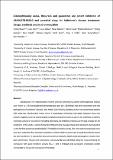Files in this item
6-benzothiazolyl ureas, thioureas and guanidines are potent inhibitors of ABAD/17β-HSD10 and potential drugs for Alzheimer's disease treatment : design, synthesis and in vitro evaluation
Item metadata
| dc.contributor.author | Benek, Ondrej | |
| dc.contributor.author | Hroch, Lukas | |
| dc.contributor.author | Aitken, Laura | |
| dc.contributor.author | Dolezal, Rafael | |
| dc.contributor.author | Guest, Patrick | |
| dc.contributor.author | Benkova, Marketa | |
| dc.contributor.author | Soukup, Ondrej | |
| dc.contributor.author | Musil, Karel | |
| dc.contributor.author | Hughes, Rebecca | |
| dc.contributor.author | Kuca, Kamil | |
| dc.contributor.author | Smith, Terry K. | |
| dc.contributor.author | Gunn-Moore, Frank | |
| dc.contributor.author | Musilek, Kamil | |
| dc.date.accessioned | 2018-01-10T00:31:40Z | |
| dc.date.available | 2018-01-10T00:31:40Z | |
| dc.date.issued | 2017-06 | |
| dc.identifier | 248866050 | |
| dc.identifier | ba669064-60f3-400e-aa79-ef0a25199a19 | |
| dc.identifier | 28067167 | |
| dc.identifier | 85020833089 | |
| dc.identifier | 000402479000004 | |
| dc.identifier.citation | Benek , O , Hroch , L , Aitken , L , Dolezal , R , Guest , P , Benkova , M , Soukup , O , Musil , K , Hughes , R , Kuca , K , Smith , T K , Gunn-Moore , F & Musilek , K 2017 , ' 6-benzothiazolyl ureas, thioureas and guanidines are potent inhibitors of ABAD/17β-HSD10 and potential drugs for Alzheimer's disease treatment : design, synthesis and in vitro evaluation ' , Medicinal Chemistry , vol. 13 , no. 4 , pp. 345-358 . https://doi.org/10.2174/1573406413666170109142725 | en |
| dc.identifier.issn | 1573-4064 | |
| dc.identifier.other | ORCID: /0000-0003-3422-3387/work/34730412 | |
| dc.identifier.other | ORCID: /0000-0001-7259-4491/work/31318394 | |
| dc.identifier.uri | https://hdl.handle.net/10023/12448 | |
| dc.description.abstract | Background : The mitochondrial enzyme amyloid beta-binding alcohol dehydrogenase (ABAD) also known as 17β-hydroxysteroid dehydrogenase type 10 (17β-HSD10) has been connected with the pathogenesis of Alzheimer’s disease (AD). ABAD/ 17β-HSD10 is a binding site for the amyloid-beta peptide (Aβ) inside the mitochondrial matrix where it exacerbates Aβ toxicity. Interaction between these two proteins triggers a series of events leading to mitochondrial dysfunction as seen in AD. Methods : As ABAD’s enzymatic activity is required for mediating Aβ toxicity, its inhibition presents a promising strategy for AD treatment. In this study, a series of new benzothiazolylurea analogues have been prepared and evaluated in vitro for their potency to inhibit ABAD/ 17β-HSD10 enzymatic activity. The most potent compounds have also been tested for their cytotoxic properties and their ability to permeate through blood-brain barrier has been predicted. To explain the structure-activity relationship QSAR and pharmacophore studies have been performed. Results and Conclusions : Compound 12 was identified being the most promising hit compound with good inhibitory activity (IC50 = 3.06 ± 0.40µM) and acceptable cytotoxicity profile comparable to the parent compound of frentizole. The satisfactory physical-chemical properties suggesting its capability to permeate through BBB make compound 12 a novel lead structure for further development and biological assessment. | |
| dc.format.extent | 14 | |
| dc.format.extent | 740526 | |
| dc.language.iso | eng | |
| dc.relation.ispartof | Medicinal Chemistry | en |
| dc.subject | Alzheimer's disease | en |
| dc.subject | Amyloid-beta binding alcohol dehydrogenase (ABAD) | en |
| dc.subject | 17β-hydroxysteroid dehydrogenase type 10 (17β-HSD10) | en |
| dc.subject | Chemical synthesis | en |
| dc.subject | Enzyme inhibition | en |
| dc.subject | Frentizole | en |
| dc.subject | QSAR | en |
| dc.subject | Pharmacophore modelling | en |
| dc.subject | QD Chemistry | en |
| dc.subject | RC0321 Neuroscience. Biological psychiatry. Neuropsychiatry | en |
| dc.subject | NDAS | en |
| dc.subject.lcc | QD | en |
| dc.subject.lcc | RC0321 | en |
| dc.title | 6-benzothiazolyl ureas, thioureas and guanidines are potent inhibitors of ABAD/17β-HSD10 and potential drugs for Alzheimer's disease treatment : design, synthesis and in vitro evaluation | en |
| dc.type | Journal article | en |
| dc.contributor.sponsor | Rosetrees Trust | en |
| dc.contributor.institution | University of St Andrews. School of Biology | en |
| dc.contributor.institution | University of St Andrews. Biomedical Sciences Research Complex | en |
| dc.contributor.institution | University of St Andrews. Institute of Behavioural and Neural Sciences | en |
| dc.identifier.doi | 10.2174/1573406413666170109142725 | |
| dc.description.status | Peer reviewed | en |
| dc.date.embargoedUntil | 2018-01-09 | |
| dc.identifier.grantnumber | A1163 | en |
This item appears in the following Collection(s)
Items in the St Andrews Research Repository are protected by copyright, with all rights reserved, unless otherwise indicated.

